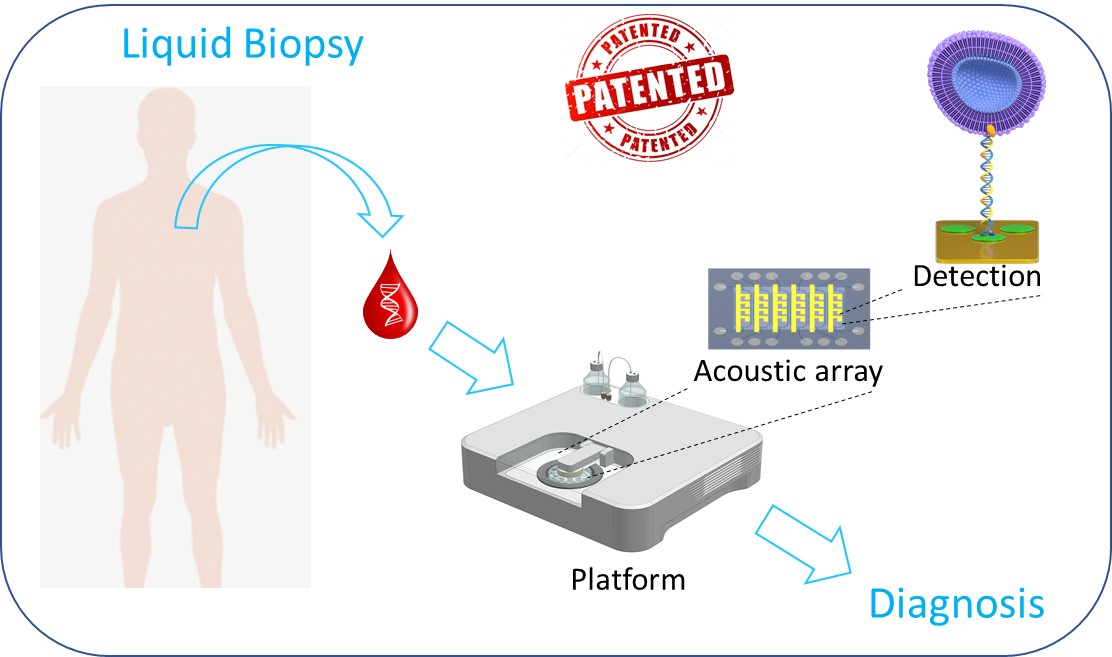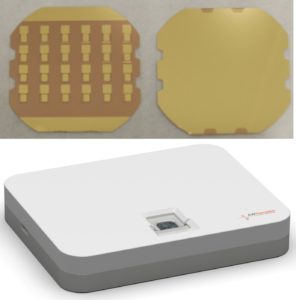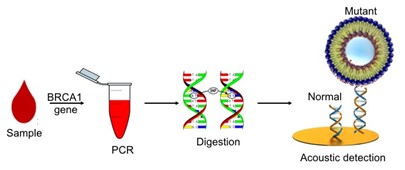Liquid Biopsy: Answers in a Blood Drop
A Promise of Early Cancer Diagnostics and Treatment Monitoring
Cancer a leading cause of death worldwide. It accounted for an estimated 10 million deaths in 2020 (WHO). Cancer management leads to one of the highest economic burdens, estimated at >30B$ in Europe alone just for the lung and colorectal cancers.
Early diagnostics and treatment monitoring are key to battling cancer.
Studies show that early detection through screening reduces breast cancer mortality in women by ~20 %, prostate cancer mortality in men by 25–32% and lung cancer mortality by ~ 30%.
Liquid biopsy – the analysis of cancer biomarkers in blood and other bodily fluids – is an emerging technology for minimally invasive early detection of cancer and monitoring of treatment progress. Wide-spread introduction of liquid biopsy into the clinic continues to face two key challenges: analytical sensitivity and cost. Innovative solutions addressing those challenges are needed to bring life-saving technology to the clinicians and to the patients.

Literature (click to expand)
Harbeck, N., Penault-Llorca, F., et al. Breast cancer. Nat Rev Dis Primers 5, 66 (2019). https://doi.org/10.1038/s41572-019-0111-2
Tsodikov A et al. Reconciling the Effects of Screening on Prostate Cancer Mortality in the ERSPC and PLCO Trials. Ann Intern Med. 2017, 167(7):449-455.
Dama E., et al. Biomarkers and Lung Cancer Early Detection: State of the Art. Cancers (Basel). 2021;13(15):3919. doi:10.3390/cancers13153919
AWSDx: Solutions to Fulfill the Promise
First Shear Acoustic Sensing Technology Prototype for Liquid Biopsy-based Cancer Diagnostics
Under the auspices of the Horizon2020 FET-Open project CATCH-U-DNA, AWSensors and FORTH, together with four more partners, developed the first prototype of AWS-X24 technology for for the detection of mutations in blood-circulating tumor DNA (ctDNA) to diagnose cancer, and validated the new technology by screening for BRAF V600E and KRAS G12G mutations in clinical samples of liquid and tissue biopsies of melanoma, colorectal, and lung cancer patients. First results have been published in N. Naoumi et al. (Acoustic array biochip combined with AS-PCR for multiple cancer mutation-analysis in tissue & liquid biopsy BIORXIV/2021/460590).

Competitive advantages of our technology are:
Superior sensitivity at a lower cost compared to the state-of-the-art methods; simplicity of operation; speed achieved through multiplexing on the 24-element acoustic arrays. The work on the design and implementation of an integrated platform and assays for the acoustic detection of the most prevalent druggable genetic mutations in lung-, breast-, colorectal cancers, and melanoma, is ongoing.
Shear Acoustic Resonator Arrays
The quartz crystal microbalance with dissipation QCMD is widely employed as a sensing technique in research labs. Effective application to clinical diagnostics or the healthcare is still limited mainly due to low sensitivity and high cost of the devices. AWSensors pioneered the development and commercialization of the high fundamental frequency (HFF) QCMD sensors and monolithic HFF resonator arrays for the use in diagnostics applications. Advantages of the new array biochip are the reduction of cost of sensors, reagents and samples as well as rapid response time. A prototype instrument, the X24 platform was designed and manufactured for monitoring the electrical response of the 24-sensor array in real time. This work is mature and ready for application in molecular diagnostics and immunoassays. To read more about the relevant technology, visit the AWSensors website, or look at one of the following publications.

The X24 prototype (below) was built to monitor the 24 array-biochip (above).
References (click to expand)
- R. Fernández, M. Calero, I. Reviakine, J. V. García’Narbón, M. I. Rocha’Gaso, A. Arnau, Y. Jiménez, “High Fundamental Frequency (HFF) Monolithic Resonator Arrays for Biosensing Applications: Design, Simulations, and Experimental Characterization,” in IEEE Sensors Journal, vol. 21, no. 1, pp. 284-295, 1 Jan.1, 2021, doi: 10.1109/JSEN.2020.3015011.
- Calero, M.; Fernández, R.; García, P.; García, J.V.; García, M.; Gamero-Sandemetrio, E.; Reviakine, I.; Arnau, A.; Jiménez, Y. A Multichannel Microfluidic Sensing Cartridge for Bioanalytical Applications of Monolithic Quartz Crystal Microbalance. Biosensors 2020, 10, 189. https://doi.org/10.3390/bios10120189.
- Ilya Reviakine, Diethelm Johannsmann, Ralf P. Richter Hearing what you can’t see and visualizing what you hear: interpreting quartz crystal microbalance data from solvated interfaces. Anal. Chem. 83, 8838 – 8848 (2011).
Hydrodynamic Sensing: Path to Superior Sensitivity
“Hydrodynamic sensing” is a concept that evolved from the insight into the relationship between acoustic wave dissipation in liquid media, the geometry of molecules or particles attached to the resonator surface and the stiffness and geometry of the linker (see reference-list below). The concept has been used extensively by Biosensor’s group at FORTH to develop conformation-sensitive molecular diagnostic assays. Demonstrated applications include the detection of cancer mutations, single nucleotide polymorphism (SNP) genotyping in mosquitoes and gene expression-quantification in mice.
Hydrodynamic sensing has also been exploited for the ultrasensitive detection of mutations in DNA through the use of liposomes or polymeric particles as amplifiers of the acoustic signal. This patented methodology was demonstrated to be able to detect, upon enzymatic amplification, 1 mutant DNA copy in the presence of 104 wild type DNAs, thus achieving an impressive sensitivity of 0.01%.

Concept of acoustic sensing of different DNAs based on their length (from Papadakis et al, Anal. Meth. 2014).

Liposomes on surface-immobilized DNA allows ultrasensitive mutantation detection due to the signal enhancement from hydrodynamic effects. Here, we use liposomes to detect the presence of a single mutation in BRCA1 gene; the latter is a prognostic/diagnostic biomarker for breast cancer.
References (click to expand)
- Quantitative determination of size and shape of surface-bound DNA using an acoustic wave sensor. Biophysical Journal, 94 (7), pp. 2706-2715, 2008.
- A. Tsortos, G. Papadakis, E. Gizeli Shear acoustic wave biosensor for detecting DNA intrinsic viscosity and conformation: A study with QCM-D. Biosensors and Bioelectronics, 24 (4), pp. 836-841, 2008.
- D. Johannsmann, I. Reviakine, E. Rojas, M. Gallego Effect of sample heterogeneity on the interpretation of QCM(-D) data: Comparison of combined QCM/AFM measurements with finite element method (FEM) modeling. Analytical Chemistry 80, 8891-8899, 2008.
- D. Johannsmann, I. Reviakine, R. P. Richter Dissipation in Films of Adsorbed Nanospheres Studied by QCM. Analytical Chemistry 81, 8167 – 8176, 2009.
- E. Tellechea, D. Johannsmann, N. F. Steinmetz, R. P. Richter, I. Reviakine Model-independent analysis of QCM data on colloidal particle adsorption. Langmuir, 25, 5177 – 5184, 2009.
- G. Papadakis, A. Tsortos, E. Gizeli Acoustic characterization of nanoswitch structures; application to the DNA Holliday Junction; Nano Letters 10, 5093-5097, 2010.
- G. Papadakis, A. Tsortos, K. Mitsakakis, E. Gizeli Characterization of DNA-Hv1 histone interactions; discrimination of DNA size and shape; FEBS Letters 584, 935-940, 2010.
- G. Papadakis, A. Tsortos, F. Bender, E. Ferapontova, E. Gizeli Direct detection of DNA conformation in hybridization processes, Analytical Chemistry 84, 1854-1861, 2012.
- G. Papadakis, A Tsortos, A. Kordas, I. Tiniakou, E. Morou, J. Vontas, D. Kardassis, E. Gizeli Acoustic detection of DNA conformation in genetic assays combined with PCR Scientific Reports 3:2033, 2013.
- G. Papadakis, E. Gizeli, Screening for mutations in BRCA1 and BRCA2 genes by measuring the acoustic ratio with QCM, Analytical Methods 6 (2) 363-371, 2014.
- Tsortos, A. Grammoustianou, R. Lymbouridou, G. Papadakis, E. Gizeli The detection of multiple DNA targets with a single probe using a conformation-sensitive acoustic sensor; Chemical Communications, 51, 11504-11507, 2015.
- Extracting the Shape and Size of Biomolecules Attached to a Surface as Suspended Discrete Nanoparticles. Analytical Chemistry, 89 , pp. 4198-4203, 2017.
- A. Tsortos, G. Papadakis, E. Gizeli, On the hydrodynamic nature of DMA acoustic sensing; Analytical Chemistry, 88 (12), 6472-6478 (2016).
- Vasilios Raptis, Achilleas Tsortos, and Electra Gizeli Theoretical aspects of a discrete-binding approach in quartz-crystal microbalance acoustic biosensing Physical Review Applied, 11, 034031, 2019.
- Acoustic Methodology for Selecting Highly Dissipative Probes for Ultrasensitive DNA Detection. Analytical Chemistry, 92 , pp. 8186-8193, 2020.
- Reut Israeli, Sofiya Kolusheva, Pablo Mateos-Gil, Electra Gizeli, Raz Jelinek, Chromatic Dendrimer/Polydiacetylene Nanoparticles, ACS Appl. Polym. Mater. 3 (6), 2931–2937, 2021.
In 2017, AWSDx received a Seal of Excellence for the Horizon2020 proposal 809040-AWSPOC, submitted under the SME instrument phase 1 call H2020-SMEINST-1-2016-2017 dedicated to the support of biotechnology SMEs for closing the gap from lab to market.

